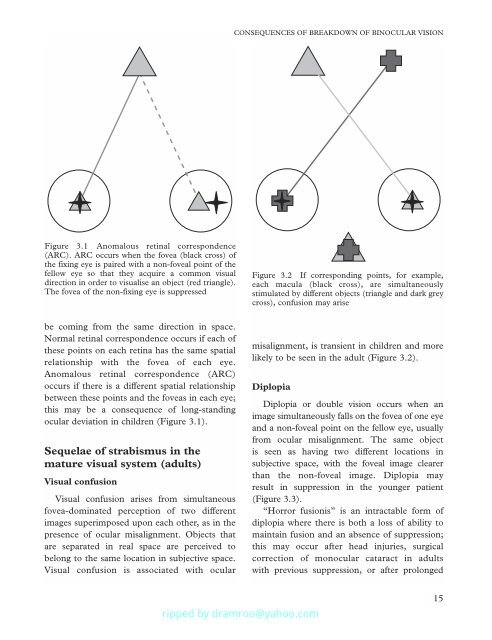Strabismus - Fundamentals of Clinical Ophthalmology.pdf
Strabismus - Fundamentals of Clinical Ophthalmology.pdf
Strabismus - Fundamentals of Clinical Ophthalmology.pdf
You also want an ePaper? Increase the reach of your titles
YUMPU automatically turns print PDFs into web optimized ePapers that Google loves.
CONSEQUENCES OF BREAKDOWN OF BINOCULAR VISION<br />
Figure 3.1 Anomalous retinal correspondence<br />
(ARC). ARC occurs when the fovea (black cross) <strong>of</strong><br />
the fixing eye is paired with a non-foveal point <strong>of</strong> the<br />
fellow eye so that they acquire a common visual<br />
direction in order to visualise an object (red triangle).<br />
The fovea <strong>of</strong> the non-fixing eye is suppressed<br />
be coming from the same direction in space.<br />
Normal retinal correspondence occurs if each <strong>of</strong><br />
these points on each retina has the same spatial<br />
relationship with the fovea <strong>of</strong> each eye.<br />
Anomalous retinal correspondence (ARC)<br />
occurs if there is a different spatial relationship<br />
between these points and the foveas in each eye;<br />
this may be a consequence <strong>of</strong> long-standing<br />
ocular deviation in children (Figure 3.1).<br />
Sequelae <strong>of</strong> strabismus in the<br />
mature visual system (adults)<br />
Visual confusion<br />
Visual confusion arises from simultaneous<br />
fovea-dominated perception <strong>of</strong> two different<br />
images superimposed upon each other, as in the<br />
presence <strong>of</strong> ocular misalignment. Objects that<br />
are separated in real space are perceived to<br />
belong to the same location in subjective space.<br />
Visual confusion is associated with ocular<br />
Figure 3.2 If corresponding points, for example,<br />
each macula (black cross), are simultaneously<br />
stimulated by different objects (triangle and dark grey<br />
cross), confusion may arise<br />
misalignment, is transient in children and more<br />
likely to be seen in the adult (Figure 3.2).<br />
Diplopia<br />
Diplopia or double vision occurs when an<br />
image simultaneously falls on the fovea <strong>of</strong> one eye<br />
and a non-foveal point on the fellow eye, usually<br />
from ocular misalignment. The same object<br />
is seen as having two different locations in<br />
subjective space, with the foveal image clearer<br />
than the non-foveal image. Diplopia may<br />
result in suppression in the younger patient<br />
(Figure 3.3).<br />
“Horror fusionis” is an intractable form <strong>of</strong><br />
diplopia where there is both a loss <strong>of</strong> ability to<br />
maintain fusion and an absence <strong>of</strong> suppression;<br />
this may occur after head injuries, surgical<br />
correction <strong>of</strong> monocular cataract in adults<br />
with previous suppression, or after prolonged<br />
15










![SISTEM SENSORY [Compatibility Mode].pdf](https://img.yumpu.com/20667975/1/190x245/sistem-sensory-compatibility-modepdf.jpg?quality=85)





